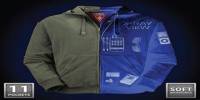A thin coating of MXene, a form of two-dimensional nanomaterial created and researched at Drexel for more than ten years, has been found to improve a material’s capacity to trap or shed heat, according to an international team of researchers led by Drexel University.
The finding, which is related to MXene’s capacity to control the flow of background infrared radiation, could result in improvements to thermal apparel, heating components, and new radiative heating and cooling materials.
The group, including materials science and optoelectronics researchers from Drexel and computational scientists from the University of Pennsylvania, recently laid out its discovery on the radiative heating and cooling capabilities associated with MXene in a paper entitled “Versatility of infrared properties of MXene” in the Elsevier journal Materials Today.
“This research reveals yet another facet of MXene materials’ versatility,” said Yury Gogotsi, PhD, Distinguished University and Bach chair professor in Drexel’s College of Engineering, who was a leader of the research. “MXene coatings possessing exceptional abilities to contain or emit infrared radiation, while remaining extremely thin 200-300 times thinner than a human hair lightweight and flexible, could find applications in both localized thermal management and large-scale radiative heating and cooling systems. There are significant advantages with passive infrared heating and cooling than traditional active ones, that require electrical power to function.”
MXenes are a family of two-dimensional nanomaterials that were first identified by Drexel researchers in 2011. As a result of their composition and two-dimensional structure, MXenes have progressively shown to have exceptional abilities for a variety of tasks, including electrical conductivity, energy storage, chemical compound filtration, and electromagnetic radiation blocking.
Materials scientists have created and thoroughly studied MXenes over the years with a variety of chemical compositions, leading to the discovery of diverse applications.
The team tested the “emissivity” of 10 distinct MXene compositions in their most recent publication, which is a measurement that correlates with their capacity to passively absorb or disperse ambient heat.
MXene coatings possessing exceptional abilities to contain or emit infrared radiation, while remaining extremely thin 200-300 times thinner than a human hair lightweight and flexible, could find applications in both localized thermal management and large-scale radiative heating and cooling systems. There are significant advantages with passive infrared heating and cooling than traditional active ones, that require electrical power to function.
Professor Yury Gogotsi
“We knew from previous research that MXenes are more than capable of reflecting or absorbing radio waves and microwave radiation, so looking at their interaction with infrared radiation, which has a much shorter wavelength, was the next step,” said Danzhen Zhang, a co-doctoral researcher in Gogotsi’s lab and co- author of the paper.
“The advantage of being able to control the passage of infrared radiation is that we can use this type of radiation for passive heating if we can contain it or passive cooling if we can dissipate it. The MXenes we tested showed that they can do both, depending on their elemental composition and the number of atomic layers.”
In comparison to the passive cooling materials available in the market today, which allow the thermal infrared radiation from the body body heat to escape through its lightweight and porous textile composition, MXene-coated textiles can do even better, according to Tetiana Hryhorchuk, a doctoral researcher in Gogotsi’s lab, and co-author of the research, because these coated textiles have the additional ability to reflect external infrared radiation, to avoid heating from sunlight, while also allowing the infrared radiation, emitted from the body, to pass.
The researchers discovered that titanium carbide demonstrated outstanding heat shielding, with its temperature rising only to 43 degrees Celsius after being heated for five minutes on a 110-degree hotplate. Niobium carbide MXenes, on the other hand, could effectively dissipate heat.
“High emissivity like in niobium carbide is also possible in dielectric materials,” Gogotsi said. “However, MXenes combine this ability with electrical conductivity, which means these MXenes can also be used as active electrical heating elements with the supply of external power.”
Materials can be made more resistant to the emission and penetration of infrared radiation by coating them with titanium carbide MXene. Even with a thin coating, MXene-coated materials outperformed polished metals, the best-performing commercial material at the time, in tests for infrared radiation shielding. This suggests that MXenes might be included into thin clothing that keeps its wearer warm in chilly settings.
The group put it to the test by dying a cotton t-shirt with a titanium carbide MXene solution and observing the wearer’s body temperature using an infrared thermal camera. According to the findings, a person wearing an MXene-coated shirt stayed roughly 10 to 15 degrees Celsius cooler at room temperature than a person wearing a typical t-shirt.
These findings imply that MXene-coated clothing is efficient at regulating body temperature and has the advantage of being applied using a relatively simpler dip-coating procedure than conventional thermal apparel.
“Commercial thermal clothes use very thin polymer fibers with low thermal conductivity fleece, for example,” said Lingyi Bi, a doctoral researcher in Gogotsi’s lab, with expertise in textiles. “They keep us warm by minimizing heat transfer through the fabric, to do this effectively they must be very thick. But MXene primarily keeps us warm by preventing the escape of the body heat as infrared radiation. Therefore, a MXene coating thinner than silk could provide effective warming. This is the same principle that is used in Mylar thermal blankets that runners get after a cold-weather race.”
According to Gogotsi, the ability to block IR might be utilized to conceal people and objects from thermal cameras or discreetly send data using radiofrequency identification codes that are only visible to infrared readers.
In order to maximize MXenes’ potential as radiative heating and cooling materials, the team intends to test MXenes with various chemical compositions and continue understanding the mechanisms underlying these materials’ IR block and emitting behavior.
















